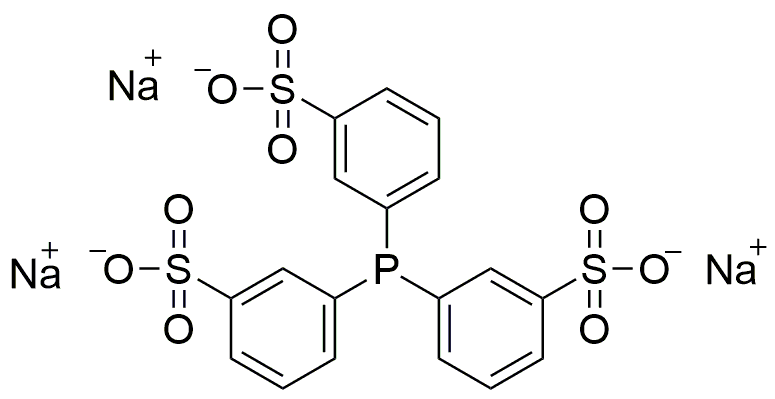Triphenylphosphine-3,3',3''-trisulfonic acid trisodium salt is widely utilized in research focused on:
- Analytical Chemistry: This compound serves as a reagent in various analytical techniques, enhancing the detection of metal ions in environmental samples.
- Pharmaceutical Development: It is used in the synthesis of phosphine-based ligands, which play a crucial role in developing new drugs and therapeutic agents.
- Organic Synthesis: The compound acts as a catalyst in organic reactions, improving yields and selectivity, which is essential for producing fine chemicals.
- Biochemistry: It is employed in the study of protein interactions, helping researchers understand cellular processes and develop biotechnological applications.
- Water Treatment: The trisodium salt form is effective in removing heavy metals from wastewater, providing a sustainable solution for industrial effluent management.
General Information
Properties
Safety and Regulations
Applications
Triphenylphosphine-3,3',3''-trisulfonic acid trisodium salt is widely utilized in research focused on:
- Analytical Chemistry: This compound serves as a reagent in various analytical techniques, enhancing the detection of metal ions in environmental samples.
- Pharmaceutical Development: It is used in the synthesis of phosphine-based ligands, which play a crucial role in developing new drugs and therapeutic agents.
- Organic Synthesis: The compound acts as a catalyst in organic reactions, improving yields and selectivity, which is essential for producing fine chemicals.
- Biochemistry: It is employed in the study of protein interactions, helping researchers understand cellular processes and develop biotechnological applications.
- Water Treatment: The trisodium salt form is effective in removing heavy metals from wastewater, providing a sustainable solution for industrial effluent management.
Documents
Safety Data Sheets (SDS)
The SDS provides comprehensive safety information on handling, storage, and disposal of the product.
Product Specification (PS)
The PS provides a comprehensive breakdown of the product’s properties, including chemical composition, physical state, purity, and storage requirements. It also details acceptable quality ranges and the product's intended applications.
Certificates of Analysis (COA)
Search for Certificates of Analysis (COA) by entering the products Lot Number. Lot and Batch Numbers can be found on a product’s label following the words ‘Lot’ or ‘Batch’.
*Catalog Number
*Lot Number
Certificates Of Origin (COO)
This COO confirms the country where the product was manufactured, and also details the materials and components used in it and whether it is derived from natural, synthetic, or other specific sources. This certificate may be required for customs, trade, and regulatory compliance.
*Catalog Number
*Lot Number
Safety Data Sheets (SDS)
The SDS provides comprehensive safety information on handling, storage, and disposal of the product.
DownloadProduct Specification (PS)
The PS provides a comprehensive breakdown of the product’s properties, including chemical composition, physical state, purity, and storage requirements. It also details acceptable quality ranges and the product's intended applications.
DownloadCertificates of Analysis (COA)
Search for Certificates of Analysis (COA) by entering the products Lot Number. Lot and Batch Numbers can be found on a product’s label following the words ‘Lot’ or ‘Batch’.
*Catalog Number
*Lot Number
Certificates Of Origin (COO)
This COO confirms the country where the product was manufactured, and also details the materials and components used in it and whether it is derived from natural, synthetic, or other specific sources. This certificate may be required for customs, trade, and regulatory compliance.


